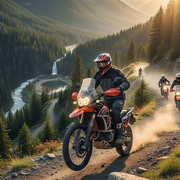Pre-Ride Safety Checklist - Don't Hit the Trail Without It
Before you fire up your bike and head out on an adventure, take a few minutes to run through this essential safety checklist. A few minutes of preparation can prevent hours of trouble on the trail!
The Motorcycle Safety Check (T-CLOCS)
For the history of T-CLOCS, from the Motorcycle Safety Foundation, check out their announcement from 2014.
T - Tires and Wheels
- Tire Pressure: Check both front and rear tire pressure when cold
- Tread Depth: Look for adequate tread and no excessive wear patterns
- Sidewall Damage: Inspect for cuts, cracks, or embedded objects
- Wheel Condition: Check for bent or damaged rims, loose spokes
Pro Tip: Lower tire pressure slightly for better traction in sand and soft terrain, but don't go below manufacturer minimums.
C - Controls
- Throttle: Should snap back quickly and smoothly
- Clutch: Check lever action and engagement point
- Brakes: Test both front and rear brake feel and effectiveness
- Steering: Ensure handlebars turn smoothly without binding
L - Lights and Electrics
- Headlight: High and low beam function
- Taillight: Brake light activation
- Turn Signals: All four signals working (if equipped)
- Battery: Check terminals for corrosion and secure connections
O - Oil and Fluids
- Engine Oil: Check level and condition
- Coolant: Verify level and look for leaks
- Brake Fluid: Check reservoir levels and fluid color
- Chain Lube: Ensure chain is properly lubricated
C - Chain and Drive
- Chain Tension: Check proper slack (usually 1.5-2 inches)
- Chain Wear: Look for stretched or damaged links
- Sprocket Condition: Check for hooked or worn teeth
- Chain Alignment: Ensure proper sprocket alignment
S - Stands and Suspension
- Side Stand: Spring return function and secure mounting
- Center Stand: Operation and condition (if equipped)
- Suspension: Check for leaks, proper sag, and smooth operation
Personal Safety Gear Check
Essential Protection
- Sturdy Boots: Ankle protection, sole protection, good tread
- Gloves: Full-finger protection with good grip
- Helmet: DOT/Snell certified, proper fit, clear visor
- Eye Protection: Goggles or face shield, clean and unscratched
- Protective Clothing: Long pants, long sleeves, even in warm weather
Recommended Upgrades
- Waterproof Boots: Waterproof motocross style boots will provide greater foot and ankle protection, between the hard metal parts of your bike and trail hazards like rocks, roots, and stumps.
- Waterproof Textile Jacket: A good quality, waterproof textile jacket with armor will keep you dry and protected from scrapes and impacts.
- Waterproof Textile Pants: Waterproof textile pants with armor will protect your legs from the elements and trail hazards.
- Waterproof Gloves: Waterproof gloves will keep your hands dry and warm, improving and control.
- Modular ADV Helmet: Modular helmets provide the protection of a chin-bar with the convenience of moving it out of the way for a chat or a quick drink, without having to take the helmet all the way off. ADV style helmets feature wider eye ports for peripheral visibility, better ventilation for off-road riding, and "peak" visors to block sun and trail debris.
Essential Supplies
Tool Kit
- Axle wrenches and tire irons
- Tire repair kit and pump/CO2 cartridges
- An extra tire tube
- Extra spark plug and plug wrench
- Zip ties and duct tape
- First aid kit
Communication & Navigation
- Fully charged phone with offline maps. Check your route and estimated mileage.
- GPS device or smartphone mount
- Contact information for your group
Supplies
- Calculate that you've got enough fuel to get to the next gas station, before you have to switch the tank to reserve.
- Extra water (more than you think you need)
- High-energy snacks
- Sunscreen and insect repellent
Weather and Trail Conditions
Before heading out, always check:
- Weather Forecast: Including conditions at your destination
- Trail Status: Check for closures, restrictions, or hazards
- Daylight Hours: Plan your return before dark
- Local Regulations: Permits, restrictions, fire danger ratings
Group Ride Considerations
When riding with others:
- Establish hand signals and communication methods
- Review the route and identify regrouping points
- Assign a sweep rider to stay with slower riders
- Share contact information with the group
- Discuss skill levels and comfort zones
Red Flags - Don't Ride If
- You feel unwell or overly fatigued
- Weather conditions are dangerous
- Your bike has any safety-related issues
- You don't have proper safety gear
- Trail conditions exceed your skill level
Remember: It's About Fun, Not Risks
The goal is to return home safely with great memories and stories to share. When in doubt, err on the side of caution. There's always another day to ride!
Have questions about safety gear or maintenance? Contact us at [email protected]
📚 For comprehensive safety information, see our complete Safety Guidelines covering emergency procedures, wildlife safety, and club policies.
Next Workshop: Basic Off-Road Techniques - Date TBD
Trail Tip: Always let someone know your planned route and expected return time!
